#and also scraps that will be generated BY THIS QUILT when i trim it
Explore tagged Tumblr posts
Text


This quilt has turned out immensely noisy lol but finally I can trim and bind it.
#crap#so much work lol#quilting#scrap quilt#and i still have scraps left orz#plus future scraps#and also scraps that will be generated BY THIS QUILT when i trim it
152 notes
·
View notes
Text


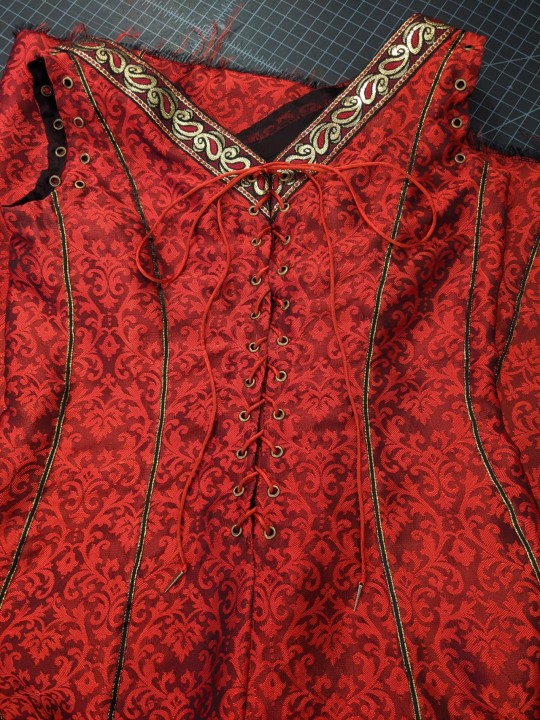




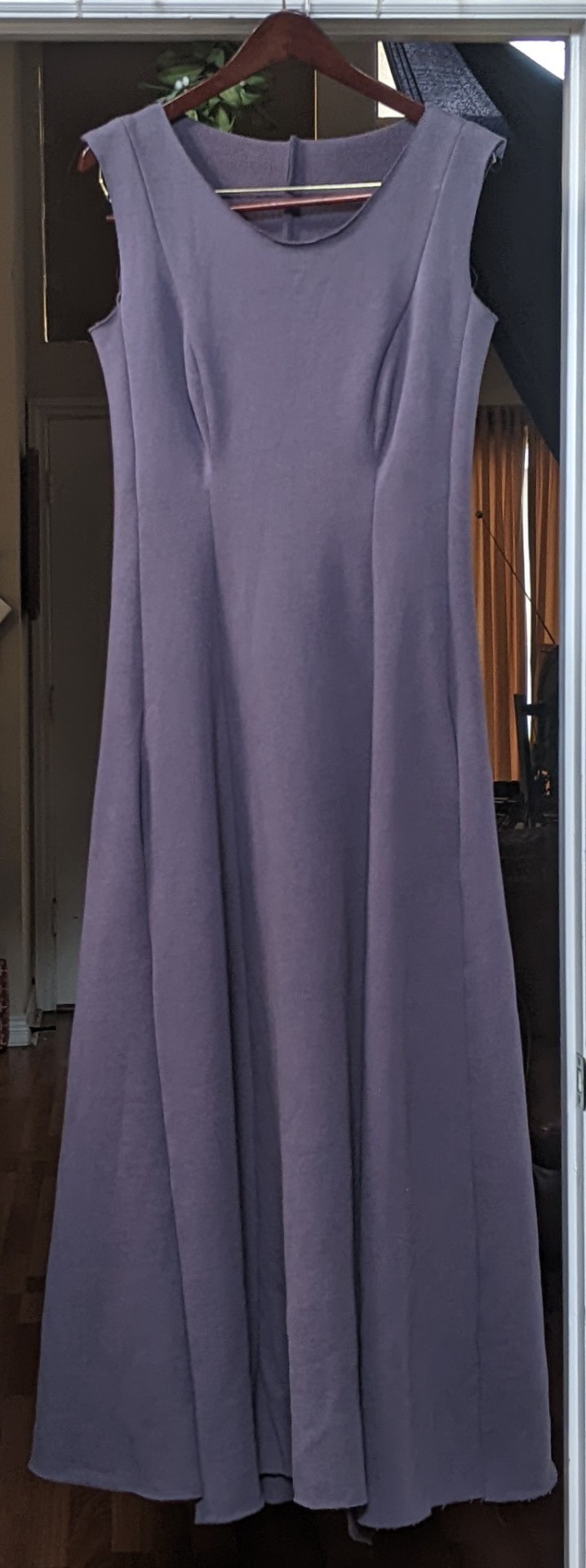
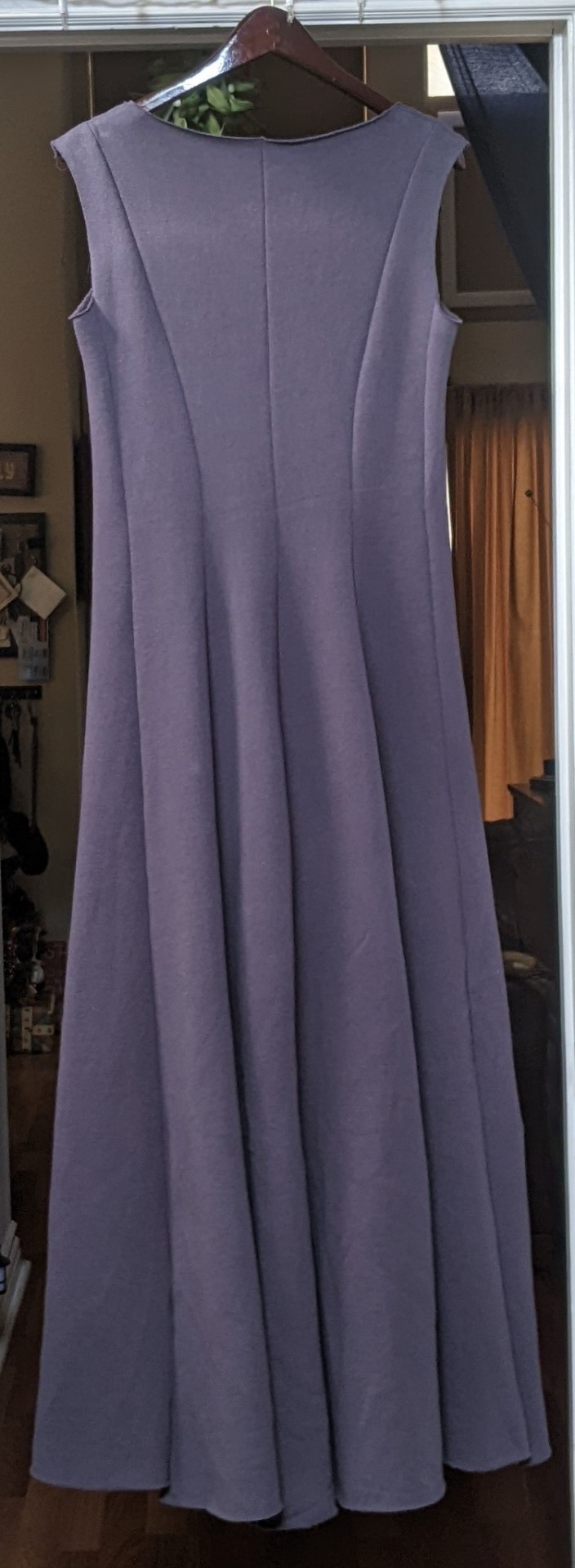
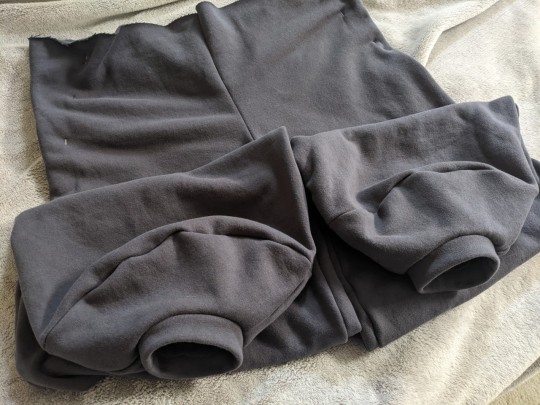
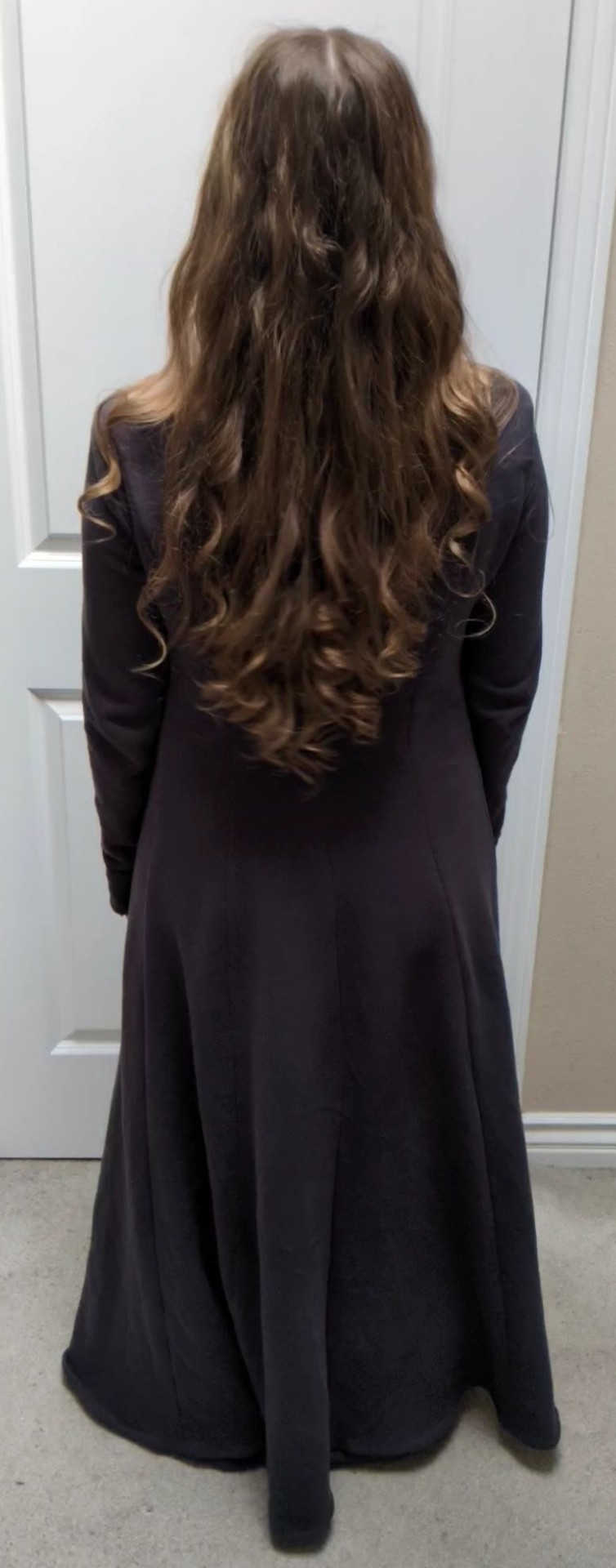
I did a lot of sewing in 2023, and spent more time on my sewing projects than on any of my other hobbies, even though I ended up with relatively few finished products. I drafted patterns, fitted mock-ups, and worked with specialty fabrics, several of them new to me. I'm pleased with how all of them came out, and feel like I improved my skills in both sewing and drafting. And most importantly, I had a ton of fun wearing each one of these projects!
The majority of the year was spent on my Rhaenyra Targaryen cosplay, starting last January with drafting a pattern from my measurements, sewing a mock-up, fitting the mock-up to achieve a more screen-accurate look, and adjusting the pattern accordingly. I worked with silk for the very first time, black silk organza for the underdress and red silk jacquard (woven by a small maker in India) for the main dress. I dyed lacing cords to match, hand-sewed several yards of trim, set a couple dozen grommets by hand, sewed on several different types of beads, and did a lot of handsewing to complete the whole thing. I worked on it continuously for just over seven months, in between work and alongside other sewing projects in the last month or so.
The other major sewing project last summer was the sequin shorts for my Harley Quinn/Taylor Swift mashup cosplay. I based them on the sequin shorts in the first Suicide Squad movie, but made them red and black to match both Harley's more typical color scheme and Taylor Swift's Red color scheme. I drafted a pattern by altering a swimsuit pattern I drafted in 2020, and made a lining out of swimsuit fabric to check the fit, then cut out the exterior sequin fabric. I'd worked with sequin fabric before, but never one with sequins attached in one continuous chain of stitches, which took a little while to figure out how to best handle to keep from unraveling when cut. I ended up handsewing extra sequins onto places of the shorts where the sequins had fallen off.
I purchased the Taylor Swift tshirt but added quite a lot of hand-sewn details, to make it look more like the Suicide Squad tshirt. In July and August I also finished a bunch of other small cosplay crafting items, everything from wig styling and jewelry making, to gluing rhinestones to a pair of bunny ears, repairing the beading on a purchased dress, and adding a hidden pocket to a purchased skirt, all in preparation for Dragon Con at the end of August.
After Dragon Con I needed a couple of months to recover, and while I did start (but not yet finish) a simple knitting project, I didn't do any sewing or pattern drafting again until late November. At that point I knew I wanted to make a cozy stay-at-home winter dress and get it finished just as soon as possible, so I could start wearing it as the weather turned colder.
I drafted a new dress pattern based on the pattern I drafted for Rhaenyra's dress, and a pair of funky wide legged pants from a pajama pant pattern I'd drafted in 2022. The whole project, from drafting the pattern and ordering a sample of the heavy fleece fabric I wanted to use, to the final hand stitching on the hem, took just under a month -- much faster than the Rhaenyra project, with much less fussy fabric and far fewer details. Now that I've gotten to wear it around the house over the last week and a half, there are a few small changes I may make to it in the future, but generally I'm very happy with it.
Currently I actually have two other sewing projects in process, too: hand-sewing/quilting the print from an old tshirt onto the back of a hoodie for Jack (slow going but getting close to done), and a surprise birthday gift for a family member. I'll post pictures of each once they're done, but probably won't post about the surprise project until the gift has been given.
After that, I have plans to start making some layering pieces to put over (and under) the fleece dress. I have some scrap fabric from older projects I'd like to turn into wearable things, and that bolt of cotton herringbone fabric I got a good deal on on Ebay arrived the other day, and needs to be washed and ironed and such before I start figuring out what I want to do with it.
I'm hoping to continue my streak of 2023 sewing into 2024, with that focus on more practical, everyday wearable items, rather than on cosplay. I don't know yet if I'm going to have any cosplay events to attend this year, and even if I do, I'd be quite happy bringing older projects, including those I finished in 2023, out to play again. As much as I love making those big show pieces for conventions, and pushing myself with new-to-me fabric types like silk and sequins, I'll get a lot more use out of everyday pieces, and feel better about my day to day wardrobe at the same time.
Thank you to everyone who liked and commented on my sewing posts throughout the year! I mostly post about my projects here as a way to document them for myself, but it's always so wonderful to hear that other people like my work, too. I hope 2024 treats all of us well, and to any of you out there with sewing projects you're working on, may your thread stay untangled and your scissors sharp!
#my sewing#2023 sewing retrospective#2023 mood#RRD cosplay#Harley Quinn Swiftie cosplay#winter fleece dress#Solstice dress
8 notes
·
View notes
Text
Unique Gift for women

Tailored Baby Blankets For ones Unique Gift
Will there be anything more comforting than the usual hand-knit baby baby blanket? It is one of those stuff that we all have attached to childhood memories involving, and therefore knitting is more than just a technique to pass the time up to the point baby arrives it's just a way of showing little one how much you care and attention.
Gifts for women
One of the nicest thoughts that anyone tends to make when they know person having a baby is to build a handmade baby surprise. It's a enjoyable tactic to spend their period to someone beaten by using crafting. A knitted blanket is 1 item that the babe can get good us going for and the parents definitely will cherish it for a long time to come. With the economical cost of wool and a free sewing pattern for infant blanket, this is an inexpensive and very desirable item.
Knitting it's nonetheless being done by way of millions of people all over the world even if isn't as widely used as it once was. That's a relaxing hobby which keeps the hands nimble. As an seasoned knitter can take some pattern for newborn baby blanket and make an property immediately. You'll be able to to create wonderful, handmade items though if you haven't at this point discover the joy associated with knitting, it doesn't acquire long to pick the application up before you know it.
Gifts for women
For people individuals who are interested, quite a few communities offer composing classes. It's not rare to see scrap booking, pottery and knitting modules taking place. You can be in a position to locate a class that will assist you create a blanket to have an infant. The costs for this type of elegance will generally consist of instruction, the wool as well as a knitting sample for baby umbrella.
This is certainly achievable if perhaps you'd rather learn from home by yourself. We can study almost any skill on the aid of the Online world. All you need to do can be locate the website this explains the fundamentals from knitting. It takes a lot of practice to get the cling of this skill. It is really certainly not complicated a lot of people attempt an item small such as a course cloth before getting into a larger task.
Knitting it's a competency that once you pickup, will be with you for the entire lifetime. Absolutely nothing is quite as distinctive as creating a product by hand. Knitting isn't actually something only older folk ladies in pensionable homes do, that's a fun and appealing hobby that any person of any their age can attempt. Picture the pride you will definitely feel when you go on a pair of knitting knitting needles, some yarn, your knitting pattern to get baby blanket.
Or simply if you don't want of which kind of hobby appearing creating your own little one blankets the one other choice here is developing a personalized baby bedding were you can find this on the market. The concept of having a special blankly only for your little one is basically appealing to many families. I love that this object will be a keepsake designed for my daughter of having in her collecting sentimental objects. The concept of creating personalized babe blankets is artistic but it isn't a cutting edge concept.
In the past ten years many moms possess made monogrammed bedsheets for their babies. Personalised baby blankets are actually spin offs connected with an old tradition that a great many families carried with regard to generations and this will make the whole thing extra extraordinary to me. I love the concept of infusing a bit of the past with the gift.
My partner and i also love that am not the only one who will be generating the personalized infant blankets for a kids. I just desire some focus on picking the right one for each toddler. It's a rare function when a mom acknowledges personalized baby covers for children this girl hasn't had still.
Fleece is always a success when it comes to keeping your little ones warm. Fleece quilts are soft in addition to soothing and are made from natural wool dust that allow the newborn baby to breathe along with keep him/her comfy and comfortable. Still I decided to neglect this material meant for my child because the device can often be a little too heat. Personalized baby bedding made from this fabric are best suited to get cold climates. Used to do like the satin fit on this one, despite the fact that.
There are also personalized little one blankets that have ribbons trim but this particular just seems much too coarse for an toddler. I would assume the particular items are largely for show and not just for use. I favor the idea of my boy caressing up to your girlfriend blanket for level of comfort better than the idea of creating a nice nursery interior design.
While chenille appeared like the perfect choice designed for my infant, We saw something that certainly took my oxygen away in personalised baby blankets. The smoothness blankets are the fantastic merge between a good stuffed animal as well as a comfort blanket. Such personalized baby bedsheets also have satin eliminate for the little one to be able to feel.
Surprising as it can certainly seem, I'm always having trouble choosing of which of the personalized babe blankets to choose. I adore the idea of the bloated animal but I actually also love the style of the chenille have as well. I guess we might just have to get a pair of. And it's time to develop a beautiful gift.
Blanket is super soft, durable, plush fleece, lightweight, 50”x60” comforting and inviting. Your friend will be reminded of how appreciated they are by someone special in life every use.
1 note
·
View note
Text
PEEPEE TEEPEE the tutorial
Man I wish these had been around when my son was little. My daughter (although she doesn’t remember it) has the horrifying story of the first time we changed her brother’s diaper at home. She got hit right in the face because she was a bit too inquisitive for her own good… and there was no such thing as a peepee teepee.
I am setting these instructions up as if you have all the time in the world to sew and are new to the game. There are tips and tricks for time saving in case you are trying to do this for a profit marked t/p no pun intended.( I tried to color code these help if you know how!) I will also note places where you probably shouldn’t cut the corners. d/s
This version is more absorbent than others I found because of the cotton batting and flannel. I always have extra batting scraps from quilts but you might find other materials. My design also takes out any raw edges so there will be less to irritate tender skin. I added a loop of ribbon because I don’t want to touch wet pee.
What you need:
My version uses the size of a bowl I found in the kitchen. The directions I found on line ranged in diameter from 6.5-8.
Marking tools
Cutting tools t/p (I successfully used my rotary cutter to cut many layers all at once. No need for marking, cutting out that step!)
Thread- can contrast for topstitching if desired
100% cotton Flannel –baby flannel I found to be the softest. The amount depends on how many you are making and the size of your bowl.
100% Cotton batting
Your favorite machine
Steam iron
Scissors
Tool for poking corners (I like chop sticks as they are not too pointy and don’t make holes in the fabric.)
Ribbon- approx. 6” per unit
Preparation:
d/s Wash or at least wet your fabric and batting and dry thoroughly before you cut!
100% cotton shrinks and these items will be washed a lot! It then pays to iron everything flat before you begin cutting. This is especially helpful if you are rotary cutting.
Marking and cutting:
t/p I discovered if my batting is slightly smaller than my flannel in the first place it helps cut time in the creation phase. ¼” is good.
I generally like to use chalk on baby things because it will wash out, but your marks aren’t going to be seen. Just make sure it isn’t something that will bleed and ruin your work.
You will need 1 full circle of flannel and 1 half circle of batting for each unit. (pictures) Creation:
Fold the flannel in half with right sides together. (picture)
Place batting on top. (picture)
Begin sewing approximately 2” from the beginning (you won’t have to fight with beginning the piece this way) using ½” seam allowance. (picture) You can make the seam allowance larger or smaller depending on your comfort zone with sewing.
t/p Smaller seam allowances let you cut this next step out! OR if you followed the first tip under marking and cutting.
With large seam allowances you need to reduce the bulk. That means trim the batting and possibly one or both layers of flannel in your seam allowance so that when you turn it there isn’t so much in the way. It is up to you which way you like the look of best, d/s but at least trim in the inside corner so your corner makes a nice point when you turn it.
Go ahead and turn it right side out. Use your chopstick to poke the corner. Finger press the edge to get the seam where you want it and tuck in the seam allowance in the open space. You can slipstitch this hole closed OR t/p iron the edge and the hole. (picture).
Topstitch the curved edge. d/s If you followed the last tip you have to make sure you get close enough to catch the seam allowance so your hole looks closed and it will be.t/p If you didn’t follow the last tip you don’t have to topstitch but it does look nicer. (picture)
Choose the side you like best and have it facing up. Fold the ribbon piece in half and lay it in the middle as pictured. Fold the unit in half so that the points come together and the ribbon stays in the fold. You may find that you are more comfortable pinning it in place and pinning the unit. d/s Start sewing part way along unless you own a tool that holds your presser foot up in back. You will waist precious time fighting with your machine. Turn it around and sew from the other direction. You may want to reinforce the ribbon area. Trim your threads and your ribbon tails. Turn it right side out.
1 note
·
View note
Text
Sewing tips for beginners
I've been sewing for a while and though I still have a lot to learn, here are some of the most important things I've discovered. 1. Keep a small bag of essential sewing equipment with you at all times. You will need it. 2. Keep in this bag: A small pair of thread snips, at least 3 needles, and thread spools in three basic colors (I suggest white, black and beige) 3. Color code everything. Fabric, thread, notions, all should be sorted neatly by color and then in shades of said color. 4. Organize!! I have a problem with this one. But it's vital! What I use every day, my embroidery, is organized because I would go insane, but my sewing machine area is horrible, and I suffer. 5. A good bag for portable sewing is an investment. Make your own or be prepared to spend a large amount. Do not use plastic bags, they break and you lose material. 6. Keep your tools clean and take good care of them. A seamstress is only as good as her/his/their equipment. 7. When you find someone who wants to learn, teach them or find them a teacher. Never, NEVER, tell them no based on superficial characteristics such as age or gender. We are practicing a dying art. I'm sixteen and I have 4 students. What have you done for your community today? 8. Make sure your student has what they need, either by directing a parent/guardian in the case of kids or even purchasing it yourself. Bias-tape creators and water-soluble pens make great Christmas gifts. That leads us to our next tip! 9. Water soluble pens. Better than chalk, they come right off fabric with no residue. Don't throw out your chalk pens yet though. You'll still need them for darker fabrics, as all water-soluble's I've found come only in blue. Heat-sensitive pens can also be useful and come away cleaner faster, but only if you have constant Iron access 10. When in doubt as to sizing, make it big. You can always trim it down. 11. Never hold thread in your mouth while wearing lipstick. Bad combination. 12. For quilt backings and the like, thrift store sheets are great. Also, buy big shirts and nightgowns and the like if they have nice fabric, then take them apart and use the fabric for something else. 13. A seam ripper is a lifesaver, be nice to it and don't let your little sister stab it through a coke can multiple times (I didn't even know she had it. She's twelve.) 14. Do not be afraid to ask for help. No one is judging you, we've all been you and are willing to explain. 15. Draw out your pieces before you cut if you don't have a pattern. If you do, pin to the fabric. 16. Ask a teacher or trusted sewing advisory to teach you how to read patterns. They are confusing. 17. If the brand of the notion matches the brand of the pattern, generic will probably be fine. But check quality of both before buying. 18. For cheap, wear-it-one-time Halloween costumes, 2 dollar a yard Walmart fabric is great. But for anything else? Avoid it. 19. Ironing your detailed embroidery can help it stay flat and not slide about. 20. Antique thread is not to be trusted. It snaps easily. 21. Wooden spools can be reused into adorable crafty projects. Save them. 22. Also save scraps. If good for nothing else, it's always good as pillow stuffing and does not clump when washed like polyfill.
11 notes
·
View notes
Text
37 Sewing Hacks You'll Wish You Knew Before Now
Sewing can be a very beneficial and practical skill to learn. Clothing by pattern (or by causing your own patterns from clothes) is difficult unless you already sew perfectly and come to it with a knowledge of how different materials react to being sewn, with what technique, how they fall easy sewing projects for beginners on your body, and how appropriate the design is perfect for your real body and this fabric. When basting, it's wise to use a contrasting thread so it is easier to take away the basting stitches after the long term sewing is complete. Suggested course: The ‘Intro to Sewing' course is aimed at complete beginners and can teach you the fundamentals of sewing. Once you've got acquainted with the basics of sewing, you'll want to begin making things! Can you how to sew imagine sewing those big heavy dresses by hand? After you have made the first skirt you might select to learn various sewing methods. Learn the right elements of your sewing machine. Would you like to learn to sew and also have no idea the place to start? One kind of practice stitching could be to sew along the edge of the fabric, so ensure that at least one aspect of your scrap items line up to each other. Your sewing machine also has different stitch adjustments how to sew to help determine stitch duration for every stitch, the amount of tension needed to make sure the stitches come through properly, and the various types of stitches (if you have the kind of sewing machine that does different stitch types). Week 1: (Saturday 27th January) Understanding the sewing machine. I've browse the machine's instructions, went to the library brought and read sewing books. There has been a large boom in online classes in every certain area you can think of. Sewing is no different. Also, is it possible how to sew a zipper to recommend any sewing machines for kids to use. A range is offered by us of over 25 different sewing classes, all thoughtfully designed and trained with our own exclusive sewing patterns. If you want to buy new sewing machine, as a beginner there are a few facts to consider. This is a l isting of all the ones Craftsy also has sewing packages, patterns , free project ideas, and more. Style how to sew by hand of the sewing machine is important to consider because several well-known brands offer sewing machines with updated features. I had started thinking, I would enjoy sewing easily could get it done by hand probably, like the embroidery. Utilizing a sewing machine is simple but it can help too much to have you to definitely show you what to do. When you can, I'd look into taking a class. This is helpful and helps to keep my sewing machine from moving while I'm using hand sewing stitches it. Taking these professional sewing tips and techniques you can easily and efficiently to fix and repair your clothes and accessories. I learned how to sew in 6th quality within an art course. The stress of focusing on a lower-quality machine where in fact the tension keeps shifting and the thread helps to keep breaking or tangling on your lovingly-pieced together task how to sew clothes can totally suck the fun out of sewing. Remember it is not only the pattern parts that are much smaller when sewing for dolls … your buttons, trims and other embellishments should be smaller, too. During sewing by hand you necessarily need use a thimble. Do this prior to you begin sewing - the fabric needs to be completely dry. You'll be becoming a member of almost 14,000 sewists who are Celebrating Creativity while getting clever sewing tips, quilting motivation how to sew a zipper, and a dash of this and that. Needle (2 if possible) - any basic sewing needle I find it helpful to study from a few different source since hardly any sewing machine is the same, and some tutorials shall mention things others won't. how to sew by hand This class is perfect for complete beginners and people who have sewn before but need a refresher you get familiar on how to use the sewing machine, it shall help build your confidence how to sew to start your new sewing projects. Worn on the center finger of the hand you generally use for sewing, modern thimbles are available in several different materials. Take up lever: Every sewing machine has one, this is actually the lever in leading of your machine (it might be somewhat recessed and a little hard to see initially) that goes up and down while keeping stress on the thread. Lisa Comfort studied at the London University free sewing classes of Fashion and caused designers before starting Sew Over It , which includes developed into a cafe in south London, a publication and numerous workshops, clubs and classes.
0 notes
Text
Fashion Tries on Zero Waste Design

Timo Rissanen with zero-waste denim pieces he designed.
YOU wear organic T-shirts. You hang your clothes to dry. You recycle your unloved suits and dresses.
But frankly, that’s just the tip of the green iceberg.
Today’s truly fashion-forward have a more radical ambition: zero waste.
That may sound more like an indie band than an environmental aspiration, but it’s a new focus of top fashion schools.
Zero-waste design strives to create clothing patterns that leave not so much as a scrap of fabric on the cutting room floor. This is not some wacky avant-garde exercise; it’s a way to eliminate millions of tons of garbage a year. Apparel industry professionals say that about 15 to 20 percent of the fabric used to produce clothing winds up in the nation’s landfills because it’s cheaper to dump the scraps than to recycle them.
A small but impassioned coterie of designers has spent the last few years quietly experimenting with innovative design techniques, and some of their ideas are starting to penetrate the mainstream.
Next month, Parsons the New School for Design — which inspired a generation of would-be designers through the television series “Project Runway” — will offer one of the world’s first fashion courses in zero waste. The book “Shaping Sustainable Fashion: Changing the Way We Make and Use Clothes,” by Alison Gwilt and Timo Rissanen, zero-waste pioneers, will be published in February by Earthscan. And an exhibition of zero-waste fashions, curated by Mr. Rissanen and another zero-waste designer, Holly McQuillan, will be held in New Zealand next spring and in New York the following fall. Also in March, an exhibition, “No Waste/Zero Waste” will open at the Averill and Bernard Leviton A + D Gallery in Chicago, part of Columbia College Chicago.
“Clearly this is an idea whose time has come,” said Sandra Ericson, founder and director of the Center for Pattern Design, which studies and educates about historical and current trends in pattern making, in St. Helena, Calif.
But it has taken a while to reach the United States. Nearly every leading zero-waste or less-waste designer hails from another country, including Mark Liu, Julian Roberts and Zandra Rhodes in England; Susan Dimasi and Chantal Kirby in Australia; Ms. McQuillan in New Zealand; and Yeohlee Teng, who is working in New York but was born in Malaysia.
Among those instrumental in pushing for change is Mr. Rissanen, a ruddy-faced Finnish designer who is Parsons’ first-ever assistant professor of fashion design and sustainability. He is teaching the new zero-waste course with Scott Mackinlay Hahn, a founder of the organic fashion label Loomstate, who, along with a colleague, will provide insights into actual business practices.

Simon Collins, far left, of Parsons, Scott Mackinlay Han and Fiona Dieffenbacher with a five-pocket jean pattern.
The goal? To create jeans that are as close to zero waste as possible but that are also good looking — no easy task. Mr. Rissanen, who is completing a doctorate at the University of Technology Sydney (his dissertation is titled, “Fashion Creation Without Fabric Waste Creation”), knows this first hand. Previously, he owned a men’s-wear label called Usvsu.
“I basically had to learn to design again,” Mr. Rissanen said of his initial forays into zero waste. “The first year and a half was a lot of trial and error.”
“A lot of error,” he underscored, looking bashfully at the floor of a workroom at Parsons and chuckling. “But that’s how you learn.”
One way to eliminate waste is to create a garment pattern — with gussets, pockets, collars and trims — that fits together like a puzzle. Such designers favor certain cutting techniques with names like the “jigsaw cut” (from Mr. Liu) and “subtraction cutting” (from Mr. Roberts). Mr. Rissanen put his on a blog, zerofabricwastefashion.blogspot.com. Another method is to simply not cut the fabric at all, but drape it directly onto a mannequin, then tuck, layer and sew.
But these techniques have not made much headway with large manufacturers. “They’re all sort of dipping a toe,” said Simon Collins, dean of the school of fashion at Parsons, “but they find it hard to commit.”
That’s partly because of the costs and existing infrastructure. For example, the standard fabric width for commercial denim production is 60 inches wide. Using a different width might change how much waste is generated, but it would also require re-engineering a supply line. And while sustainable design does not necessarily cost more, overhauling a factory is obviously expensive. Loomstate, for one, has backed away from a big production of denim until it can do so more efficiently, Mr. Mackinlay Hahn said.
Even as schools like Parsons teach the next generation of designers to make sustainability a core part of their creative process, few brands or retailers are powerful enough to bring about a supply line reinvention. An exception is Wal-Mart. The nation’s largest retailer has used its power to change the items sold on its shelves, telling suppliers that it would proffer only fluorescent light bulbs (which use up to 75 percent less electricity than incandescent bulbs) and concentrated liquid laundry detergent (which uses 50 percent less water). In 2008, the retailer set forth a long-term goal of zero waste in all its stores. Yet even for a behemoth like Wal-Mart, that goal is far from being realized.
Fashion labels striving for zero waste have an added dilemma: not sacrificing style for sustainability.
“If it doesn’t look good,” Mr. Mackinlay Hahn said, “it’s not going to sell.”
Students in the new Parsons class will be asked to figure out how to create zero-waste jeans without compromising style.

Jeans at an industrial park in Nicaragua. Their popularity is a challenge for zero waste design.
“Jeans are one of the most wasteful and polluting garments that are made,” said Mr. Collins of Parsons, citing not only the unused fabric, but also the dyes added only to be washed out again, the energy used to transport the denim all over the world, the packaging, and the gallons of water used by consumers to clean the jeans. “And of course it’s one of the staples of everyone’s wardrobe.”
Students in the class will explore how to change the way jeans are made and cared for, from sourcing fibers that have not been exposed to pesticides or fertilizers, to how frequently consumers wash their denim. The top design will be manufactured at Loomstate’s California factory and sold next spring at Barneys New York.
“What that will do is prove to the big companies that you can do zero waste and make money out of it,” Mr. Collins said.
But that will depend on whether unconventional jeans will sell. One recent morning at Parsons, Mr. Rissanen rearranged on a swath of denim the muslin pattern for a classic five-pocket jean, showing how much fabric could be saved if the design were somehow different — fewer pockets perhaps, or adding embellished seam detailing.
Another option is to use fabric scraps to decorate a garment with curlicues and flowers. Excess fabric could also be used to make something entirely new (American Apparel, for example, has used excess material to create accessories and underwear). But Mr. Rissanen said the challenge of zero waste is to keep the design driven by function.
In some ways, zero waste is not new. Throughout history, consumers have had to adopt similar practices, such as rationing during wars, when women fashioned new outfits from old ones. Also, classic hobbies, like knitting and quilting, can be zero-waste endeavors.
Indeed, Mr. Rissanen became interested in the concept about six years ago, when he was studying 19th- and 20th-century designers like Madeleine Vionnet, a French dressmaker known for her use of the bias cut, whose work suggested that zero waste was possible. Additionally, his family has always gravitated toward what one might charitably call sustainable practices. Or as Mr. Rissanen put it: “I’m from a very thrifty family.”
In the second half of the Parsons class, students will try to make jeans more sustainable in their post-retail life. That means rethinking how jeans are cared for and, eventually, disposed of. The students may, for instance, establish a campaign encouraging consumers to use less detergent and to wash denim in cold water.
“We’re offended by 15 percent waste in fabric,” Mr. Collins said. “We believe in great design. But we don’t believe in wasting clothes.”
Source: The New York Times http://www.nytimes.com/2010/08/15/fashion/15waste.html
#zerowaste#getzerious#savetheplanet#gogreen#betterlife#makeachange#zeriouslifestyle#ecofriendly#ecolove
0 notes